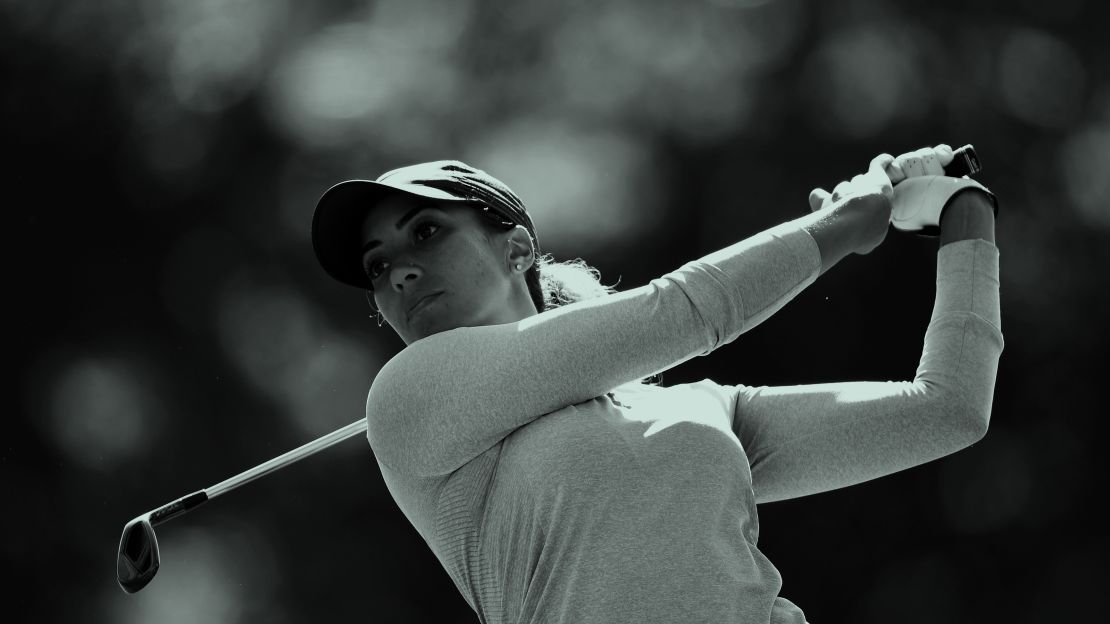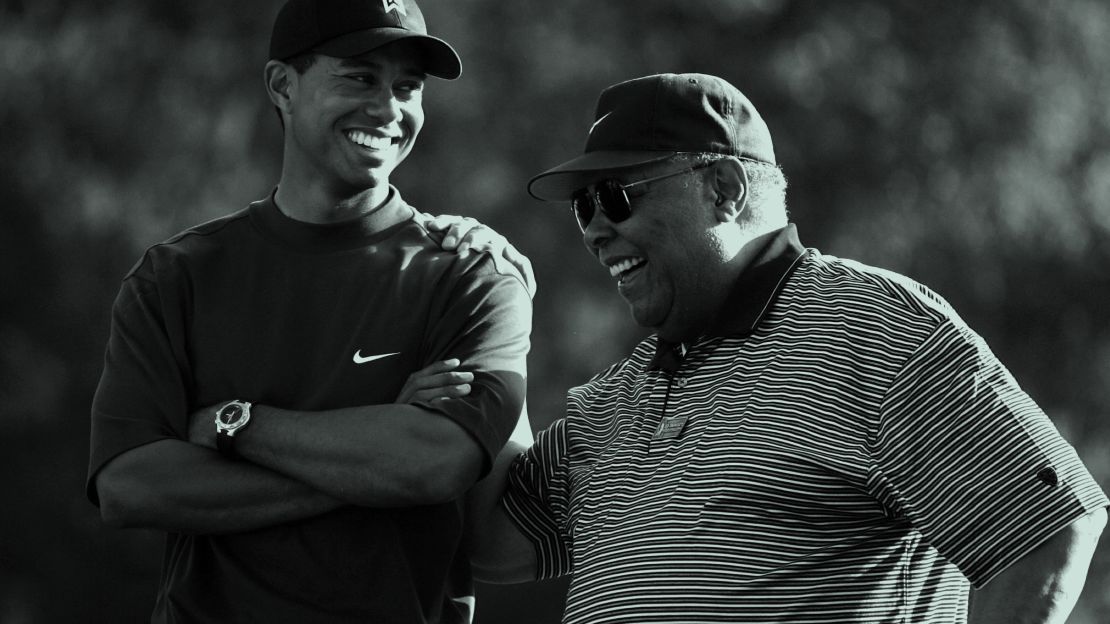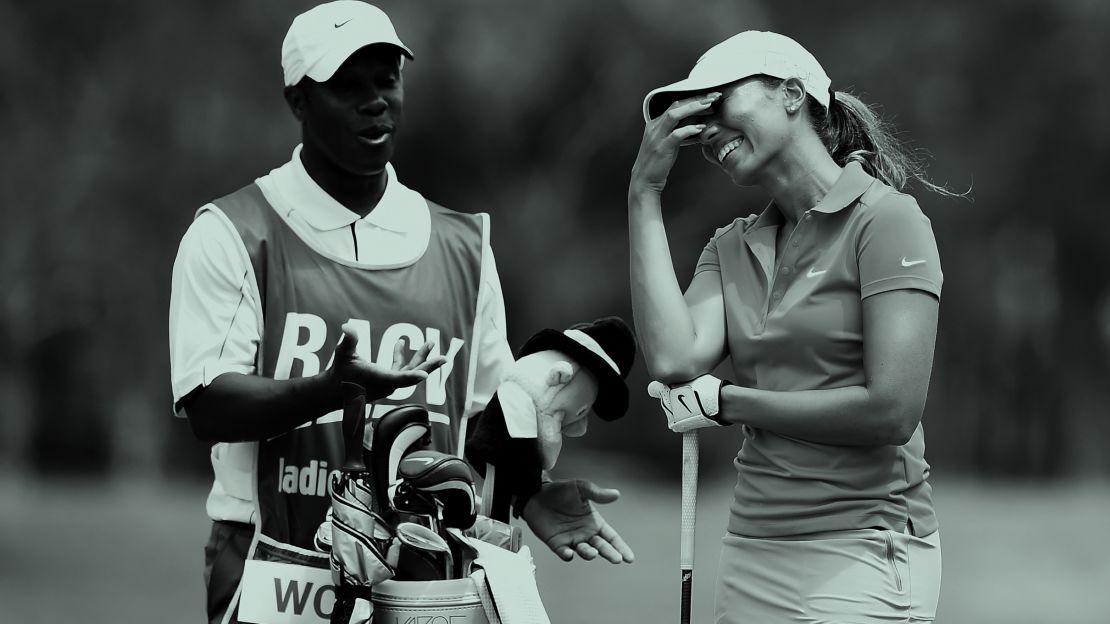Story highlights
Woods in her third year on the LPGA Tour
She is niece of Tiger Woods
Aiming to become the first African American winner on Tour
Cheyenne Woods was playing in an event at Wilshire Country Club in Los Angeles earlier this year when she was introduced to a family who had come to watch her. They had never played golf, or even seen the sport live, but Woods had captured their imaginations. “It was a black family who’d come out; a dad, his two daughters and his son,” Woods tells CNN Sport. “They’d never played golf, but they’d heard about me and came out and followed my entire round. That kind of stuff gives me goosebumps.”
Though the American has yet to win a major tournament and is ranked No.245 in the world, Woods has always attracted attention. It comes with the territory of being the niece of Tiger Woods, the world’s most famous golfer. Ever since she started playing junior tournaments, cameras have followed her. She is untroubled by it. She knows of no other world. There are positives to the interest, she says, as well negatives.
“With Tiger’s career, with him taking a break, being injured and now being back, there’s always something to talk about with him so people are a bit curious, which is understandable,” says Woods, whose late grandfather, Earl Woods – Tiger’s father – first put a club in her hand, aged three. “Some of the biggest frustrations I’ve had in my career is always being known as someone’s relative versus myself. Now I do feel I have my own identity, whether it’s the headline or not.”

Now in her third year on the LPGA Tour, Woods is not just a golfer with a big name. Much like her 14-time major-winning uncle is to millions around the world, the 28-year-old wants to be an inspiration, to make it easier for black women to follow her path to the tee. “When I was growing up, there wasn’t anybody on the LPGA Tour,” Woods, the sixth African-American woman to earn a LPGA Tour card, tells CNN Sport. “Obviously, I loved watching Annika Sorenstam and Grace Park, but as a young child looking to someone I could really relate to and have some kind of connection with, I felt that was lacking.”
Showing that it is possible
Four African-Americans compete on the LPGA Tour with Mariah Stackhouse, ranked 121 in the world, and Woods the most prominent. Such numbers do not do much to rid golf of the image of a sport for the rich and, predominantly, white; a sport where Clifford Roberts, co-founder of Augusta National, once said: “As long as I’m alive, golfers will be white, and caddies will be black.”
More than two decades since Tiger Woods won his first major at the 1997 Masters - a tournament which only welcomed its first black player in 1975 – his ascent remains an outlier. Only eight African-American women have been members of the LPGA Tour in its 70-year history. “I think it’s important for me to at least show representation on Tour,” says Woods. “To show that it is possible because that’s what Tiger showed me and people like Serena Williams and even WNBA (Women’s National Basketball Association) players showed me.

“As a young child you’re watching a sport, it almost seems a little unattainable or too far away if you can’t have a connection or relate to someone in particular. That’s how I felt at least. When you find something you can relate to, you find that’s a step forward to, ‘I can do it, too’ or ‘I want to be like her.’ If I can provide that for somebody, that’s great. Or even if I can get them into watching golf that’s great. I’d love that.”
Woods believes there is more diversity in the sport now than when she first began playing on Tour in 2014. Programs like The First Tee, she says, have helped. The initiative, funded by the game’s biggest bodies in the US, takes the sport to economically disadvantaged areas, helping those aged from 7 to 18.
But an African-American has never won on the women’s circuit, and that remains Woods’ chief aim.
“There’s been huge progress made in the game,” she says. “Tiger has had a huge influence on that but, I think, the different programs of making golf accessible and have people introduced to it a little bit more has had a huge influence.
“But, looking forward, there definitely will be [an African-American LPGA winner], whether it’s me or Mariah Stackhouse. She’s an amazing player out of Stanford University and there are a lot of great college players, so it’s exciting.
“It’s funny, we all know each other, we’re all super close and we’re all cheering each other on so it’s great to have that support out there with each other and I’m hoping with us now being out on Tour on a more regular basis we’re able to inspire other young girls.”
Fighting for equality
Successful female golfers are well rewarded – Thailand’s Ariya Jutanugarn heads the LPGA Tour money list this season with prize money of $2.2 million – but the bounty on offer is dwarfed by the rewards enjoyed by their male counterparts.
The men’s top-ranked golfer, Dustin Johnson, has taken home more than $7.7 million this term and has won more than $55 million in prize money over his career.
Forbes’ recent list of the 50 highest-paid athletes did not include any females which, Woods says, was not a surprise. “It was disappointing to see,” she adds.
“It’s inspiring to see women like Serena out there dominating her sport and being so successful. I think she’s definitely the inspiration of what’s possible but, overall, I think the climate of men and women’s sports and equal pay there’s a lot of improvement to be had.”
Progress has been made in golf, she says, and Woods regards the mixed European Tour event in Australia earlier this year, where sponsors provided equal pay, as a success.
The key, says Woods, is to give fans the opportunity to watch women play. “That’s a big thing, giving women exposure and giving the fans an opportunity to see the skill and see the talent. I think you have to at least give an opportunity to fans to watch. On the women’s side, every year we’re getting more TV time but it’s not always the prime TV spots compared to the men’s, so it’s a little bit more difficult. If you give the fans a chance to appreciate and watch the game, that’d be a great start.”
A grandfather’s lasting influence
Until his death, in 2006, Earl Woods would tell his granddaughter that she would, one day, become a professional golfer. “He was really the one who got me excited about the game, guided me through my junior career,” she fondly recalls.
“Even to this day he’s a huge factor in me pushing myself to become what I feel I’m capable of, and what he thought I was capable of as well. It’s difficult to explain. He passed away when I was in high school, but he always spoke about how he knew I would be on the LPGA Tour so that always stuck with me, the belief he had in me at a young age.”
It was Earl Woods, a former Green Beret and Vietnam combat veteran, who was the driving force behind Tiger’s rise. During a childhood spent on the course, Tiger would dream with his dad of conquering the world, of shaking up the sport. It is rare, admits Woods, for her not to be asked about her famous uncle during an interview. But, on the bright side, who better to ask for advice than a former world No.1 with 79 PGA Tour victories and career earnings of over a billion dollars?

“He’s been a huge inspiration for me,” says Woods. “Since I’ve been professional he’s been very helpful and just been willing to help. Whether it’s me struggling with a string of missed cuts or just needing a putting tip. He’s been great with helping with that. It’s difficult being a professional golfer and he gets it. No one else in my family plays golf. When I do need someone to bounce something off, or try to get some advice, he’s always been great.
“I do feel I have my own identity now and I don’t feel as much pressure with expectation or anything of that sort. I still get tons and tons of questions but I feel that will always be there because of who he is.

“I’ve had a handful of interviews [where there’s no question on Tiger] but they’re few and far between. Week to week, I don’t have that much attention. But if it’s a US Open week or, let’s say, I’m up towards the top of the leaderboard, I definitely get more attention than normal, strictly because of my name. I think I almost thrive on it. My caddie always jokes that I hit some of my best shots when the TV cameras are there, so maybe I need them around a little more!
“Growing up with doing interviews and having media attention has prepared me for when I am playing my best golf and when I am in contention. I think it’s prepared me to learning to deal with it, or block it out, or just embrace it.”



